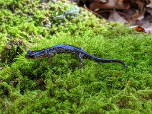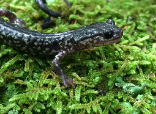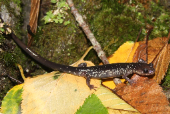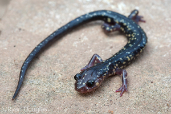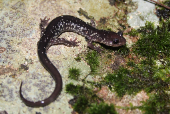Cow Knob Salamander (Plethodon punctatus)
Description: The Cow Knob salamander is a moderately large plethodontid. The largest recorded length is 6.7 inches, though most adults have a total length smaller than 6.2 inches. Around half of the total length is tail. The base coloration is dark brown or greyish-black. The sides and legs are colored with large white or cream spots, which may extend onto a portion of the belly. The back is typically speckled with smaller and more scattered spots. The species name ‘punctatus’ (“spotted”) is in reference to these dorsal spots. The throat has a light pink or pale coloration which transitions to the grey belly.
Habitat: Cow Knob salamanders are adapted to live in high-elevation hardwood forests with dense canopy cover and talus. Old-growth forests and hemlock stands are greatly preferred, while young pine monocultures and clearings are avoided. They typically occur at an elevation of 3,000–3,900 feet, with some reports as low as 2,411 feet. They are particularly abundant on north-facing slopes with an ample supply of rocks for cover. Rocks with large gaps underneath are the preferred form of refuge, followed by fallen logs.
Range: This species can be found in the Shenandoah, North, and Great North Mountains and George Washington National Forest in Virginia (Augusta, Rockingham, and Shenandoah counties) and West Virginia. It occurs at elevations ranging between 735–1,200 m asl (but mainly from 900–1,200 m asl).
Found in these States:
VA |
WV
Diet: They forage on cool wet nights, prioritizing the forest floor but also venturing onto trees or rocks. A wide range of small invertebrates are taken as prey.
Reproduction: Cow Knob salamanders are direct developers, mating via spermatophore in the late winter or early spring. A clutch of 7-16 eggs can be laid every other year, though the precise timing is unknown. Juveniles hatch in the fall and reach sexual maturity within 3 or 4 years, with females maturing later and at a larger body size.
Status: Listed as Near Threatened because the continued survival of this species is dependent on the protection and management of its habitat provided by George Washington National Forest. Without this level of protection, it is very likely that the species’ habitat would be degraded and fragmented resulting in significant population declines, which would warrant an immediate uplisting to Vulnerable.
»» Kingdom: Animalia - Animals
»» Phylum: Chordata - Chordates
»» Subphylum: Vertebrata - Vertebrates
»» Class: Amphibia - (Amphibians)
»» Order: Caudata - Salamanders
»» Family: Plethodontidae - Lungless Salamanders
»» Genus: Plethodon
»» Species: Plethodon punctatus - Cow Knob Salamander
This article uses material from the Wikipedia article "Cow Knob Salamander", which is released under the Creative Commons Attribution-Share-Alike License 3.0. Content may have been omitted from the original, but no content has been changed or extended.
|


